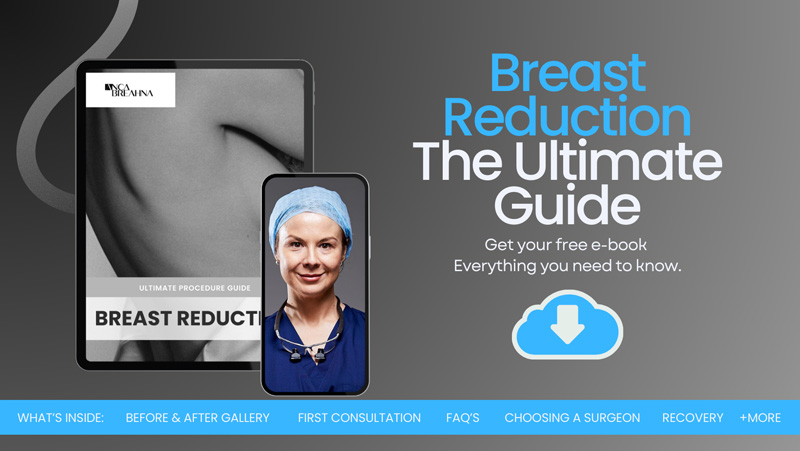
Solutions for Overly Large Breasts – Breast Reduction Surgery
Large breasts, while often considered a symbol of femininity and beauty in many cultures, can sometimes pose significant health challenges for many women. The physical strain, pain and discomfort associated with having disproportionately large breasts can impact various aspects of a woman’s life, from her posture and physical activity to her self-esteem and mental well-being.
Anca Breahna, PhD, MSc, FEBOPRAS, FRCS (Plast) is a distinguished Chester Consultant Plastic Surgeon with expertise in Aesthetic and Reconstructive Plastic Surgery. She stands out as one of the few female Plastic Surgeons in her region, bringing a unique perspective to her practice, characterised by empathy, meticulous attention to detail, and personalised care.
Download Miss Anca Breahna Breast Reduction Guide

Physical Strain and Discomfort Caused by Large Breasts
One of the most immediate and noticeable impacts of having large breasts is the physical discomfort they can cause. The weight of the breasts can put a strain on the neck, shoulders, and back. This strain can lead to chronic pain in these areas, making everyday activities, such as standing, walking, or even sitting, uncomfortable. Over time, this can lead to more severe musculoskeletal problems, including chronic back pain, spinal issues, and posture problems.
The skin beneath the breasts can also suffer. Due to the weight and size of the breasts, the skin underneath can become irritated, leading to rashes, infections, and other skin conditions. This is especially problematic in warmer climates or during physical activity when sweat can exacerbate these conditions.
Impact on Physical Activity
Large breasts can also be a hindrance when it comes to physical activity. Many women with large breasts find it challenging to participate in certain exercises or sports due to the discomfort or pain caused by the movement of their breasts. This can lead to a reduced level of physical activity, which has its own set of health implications, including increased risk of obesity, cardiovascular diseases, and mental health issues.
What Is Macromastia?
When it comes to medical terminology, the term “macromastia” might not be as commonly known as its layman counterpart, “large breasts.” However, understanding macromastia is crucial for those seeking to comprehend the broader implications of having excessively large breasts.
Macromastia, also known as gigantomastia in its most extreme form, refers to a medical condition where the breasts are disproportionately large compared to the rest of the body. It’s not just about aesthetics or societal standards of beauty; it’s about a physical condition that can lead to a host of health issues.
How Is Macromastia Diagnosed?
The diagnosis of macromastia isn’t solely based on specific breast weight or size. Instead, it takes into account the individual’s overall anatomy, body proportions, and the physical or psychological discomfort caused by the breast size. If a woman has exceptionally large and heavy breasts that lead to discomfort or medical complications, Anca Breahna or a medical professional might diagnose her with macromastia.
The Implications of Macromastia
Women with macromastia often face a range of challenges:
- Physical Discomfort: As previously discussed, the weight of excessively large breasts can lead to neck, shoulder, and back pain. This discomfort can hinder daily activities and reduce the quality of life
- Skin Issues: The skin beneath and between the breasts can become irritated due to constant friction and moisture. This can lead to rashes, infections, and fungal conditions
- Psychological Impact: Beyond the physical challenges, there’s a significant psychological toll. Women with macromastia might feel self-conscious, leading to reduced self-esteem and potential mental health issues like anxiety or depression
- Limitations in Activities: Physical activities, from exercise to even simple tasks, can become challenging. This can lead to a sedentary lifestyle, further compounding health risks
Breast Reduction Surgery – Is It Right for You?
The decision to undergo breast reduction surgery is a deeply personal one. While the physical discomfort and health issues associated with large breasts are evident, the emotional and psychological factors also play a significant role in this decision-making process.
For many women, the decision to undergo breast reduction isn’t solely based on aesthetics. The daily discomfort, pain, and limitations in physical activities can become overwhelming. Simple tasks like exercising, choosing clothing, or even sleeping can become challenges. Moreover, the constant attention or comments about one’s breast size can take a toll on mental well-being.
Weighing the Benefits
Breast reduction surgery offers numerous benefits:
- Physical Relief: One of the most immediate benefits post-surgery is the alleviation of physical discomfort. The reduced weight and size of the breasts can lead to significant relief from back, neck, and shoulder pain
- Improved Posture: With the weight of the breasts reduced, many women find their posture improving, reducing the strain on the spine and muscles
- Enhanced Physical Activity: Without the discomfort and limitations posed by large breasts, physical activities, from daily tasks to sports, become more accessible and enjoyable
- Boosted Self-Esteem: For many, the surgery brings about a renewed sense of confidence and self-worth, free from the self-consciousness or attention associated with having large breasts
Considering the Risks
Like any surgical procedure, breast reduction comes with its set of risks. Potential complications can include scarring, changes in breast or nipple sensation, issues with breastfeeding, and asymmetry in breast size. It’s important to discuss these risks with Anca to make an informed decision.
The Process of Undergoing Breast Reduction Surgery
Breast reduction surgery, or reduction mammoplasty, is a procedure that aims to reduce the size and weight of the breasts, reshaping them to be more in proportion with the rest of the body. For those considering this surgery, understanding the process can help alleviate concerns and set clear expectations.
Initial Consultation
The journey begins with an initial consultation with Anca Breahna. This meeting serves multiple purposes:
- Assessment: Anca will assess the size, shape, and condition of the breasts, taking detailed measurements and possibly photographs for medical records
- Discussion: This is the time to discuss desired outcomes, potential risks, and the surgical approach. It’s also an opportunity for patients to ask questions and voice any concerns
- Medical History: A thorough medical history will be taken to ensure the patient is a suitable candidate for surgery. This includes discussing any previous surgeries, medical conditions, medications, and allergies
Preparing for the Surgery
Once the decision to proceed with the surgery is made, there are several preparatory steps:
- Medical Tests: Blood tests and possibly mammograms might be ordered to ensure the patient’s health and safety
- Medications: Some medications or supplements might need to be adjusted or discontinued before the surgery
- Lifestyle Changes: Patients might be advised to quit smoking, as it can interfere with the healing process. Dietary or activity adjustments might also be recommended
The Surgery
The specific surgical technique used can vary based on the patient’s anatomy and desired results. However, the general steps include:
- Anaesthesia: The surgery is performed under general anaesthesia, ensuring the patient is asleep and feels no pain
- Incisions: The surgeon will make incisions, the pattern of which can vary. Common techniques include the anchor, vertical, or periareolar incision patterns
- Reshaping: Excess breast tissue, fat, and skin are removed. The nipple and areola might be repositioned or resized
- Closing the Incisions: Once the desired shape is achieved, the incisions are closed using sutures
Post-Surgery and Recovery
After the surgery, patients are observed for a short period before being discharged. Recovery guidelines might include:
- Wearing a Support Bra: A special surgical or support bra might be recommended to support the breasts as they heal
- Managing Pain: Pain, swelling, and discomfort are common post-surgery. Pain medications will be prescribed to manage these symptoms
- Activity Restrictions: Patients will be advised to limit physical activity, especially lifting or strenuous exercises, for several weeks
- Follow-up Visits: Regular check-ups with Anca are essential to monitor healing and address any concerns
Combining Breast Reduction with Other Breast Procedures
Breast reduction surgery primarily focuses on reducing the size and weight of the breasts to alleviate physical discomfort and achieve a more proportionate appearance. However, some patients may choose to combine breast reduction with other breast procedures to further enhance the overall aesthetic outcome or address specific concerns. Here’s a closer look at some of these combined procedures:
Enhancing with Implants Post-Reduction
While it might seem counterintuitive to some, combining breast reduction with implants is not uncommon. The primary goal of a reduction is to remove excess tissue and weight, but implants can be used to achieve a specific shape or fullness, especially in the upper part of the breast. This combination can provide a lifted, youthful appearance while maintaining a manageable and comfortable size.
Lifting and Tightening with a Mastopexy
Over time, the effects of gravity, weight fluctuations, and ageing can cause the breasts to sag. A breast lift, or mastopexy, aims to raise and reshape sagging breasts. When combined with reduction, it ensures that the newly resized breasts also have an uplifted and perky appearance.
During a combined reduction and lift, excess skin and tissue are removed, the nipple and areola are repositioned, and the remaining breast tissue is reshaped and lifted. The result is a smaller, firmer, and more youthful-looking breast.
Benefits of Combining Procedures
- Enhanced Aesthetic Outcome: By addressing size, shape, and position simultaneously, patients can achieve a more comprehensive transformation, ensuring that the breasts are not only smaller but also aesthetically pleasing
- Cost-Effective: Combining procedures can be more cost-effective in the long run, as patients undergo anaesthesia and recovery only once, reducing overall medical and downtime costs
- Single Recovery Period: Undergoing multiple procedures at once means patients only have to go through the recovery process once, minimising the total downtime and allowing for a quicker return to daily activities
FAQs about Breast Reduction Surgery for Large Breasts
Can I undergo breast reduction and breast augmentation simultaneously?
- Yes, it’s possible to combine breast reduction with augmentation. While the primary goal of reduction is to remove excess tissue, augmentation using implants can help achieve a specific shape or fullness. This combination can provide a balanced, youthful appearance while ensuring the breasts remain at a comfortable size. However, the decision should be made in consultation with Anca to determine the best approach for your individual needs.
How long is the recovery period after combining breast reduction with other procedures?
- The recovery period can vary based on the individual and the extent of the procedures performed. Generally, most patients can return to light activities within a week and resume more strenuous activities after 4-6 weeks. Combining procedures might extend the initial recovery period slightly, but it also means patients undergo the healing process only once, rather than multiple times for separate surgeries.
Will combining breast reduction with a lift affect breastfeeding in the future?
- Both breast reduction and breast lift surgeries involve repositioning the nipple and, in some cases, removing or altering milk ducts. This can potentially impact the ability to breastfeed in the future. If breastfeeding is a concern, it’s essential to discuss this with Anca before the procedure to determine the best surgical approach.
Are the scars from combined procedures more prominent than from a standalone breast reduction?
- The scarring from combined procedures largely depends on the specific surgeries involved. A breast lift, for instance, might involve similar incisions to a breast reduction, so the scarring could be comparable. However, the skill of the surgeon, post-operative care, and individual healing factors play a significant role in scar appearance. Over time, with proper care, scars typically fade and become less noticeable.
Is it more cost-effective to combine breast reduction with other procedures?
- In many cases, combining procedures can be more cost-effective in the long run. Patients undergo anaesthesia, surgery, and recovery only once, which can reduce overall medical costs. Additionally, there’s the added benefit of reduced downtime, meaning a quicker return to work and daily activities. But the exact cost can vary based on the procedures chosen and the plastic surgeon’s fees.Top of FormBottom of Form
Further Reading about Breast Surgery with Consultant Plastic Surgeon Anca Breahna
- Read more about Breast Reduction
- Read more about Do I Need a Post Op Bra after Breast Surgery?
- Read more about What Is Normal during Breast Reduction Recovery
- Read more about how to Reduce Swelling and Bruising after Breast Reduction Surgery
- Read more about How Soon Can I Exercise after Breast Reduction Surgery
- Read more about 9 Things You Need to Do After Breast Reduction Surgery
- Read more about 8 Myths about Breast Reduction Surgery
- Read more about How to Reduce Scars after Breast Reduction Surgery
- Read more about Causes and Treatment of Overly Large Breasts – Macromastia
- Read more about Solutions for Heavy Breasts
- Read more about Causes and Solutions for Huge Breasts (Gigantomastia)
Medical References about Breast Reduction
- Breast Reduction Surgery – Mayo Clinic
- Breast Reduction – Cleveland Clinic
- Breast Reduction – NCBI
- Breast Reduction Surgery: Everything You Need to Know – Medical News Today
- Breast Reduction Surgery – WebMD



 Ms Anca Breahna, PhD, MSc, FEBOPRAS, FRCS (Plast) is a highly regarded Consultant Plastic Surgeon specialising in the field of Aesthetic and Reconstructive Plastic Surgery. Anca performs a range of
Ms Anca Breahna, PhD, MSc, FEBOPRAS, FRCS (Plast) is a highly regarded Consultant Plastic Surgeon specialising in the field of Aesthetic and Reconstructive Plastic Surgery. Anca performs a range of 